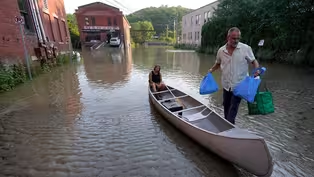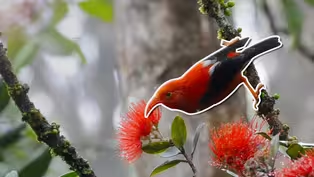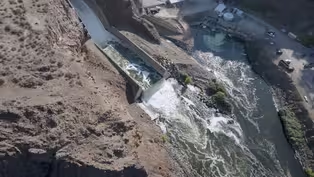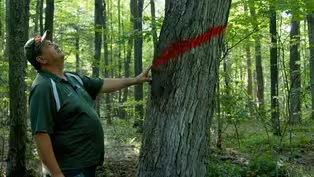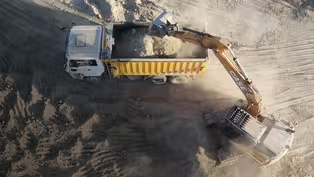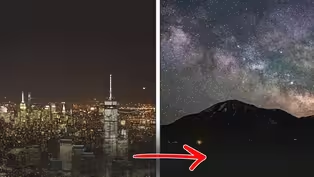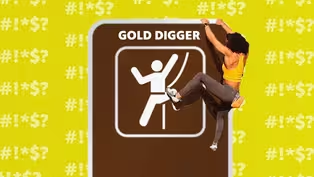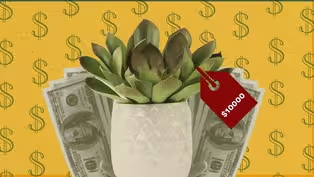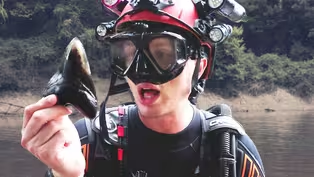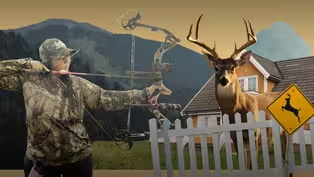
Understory | The Scientist Surfing to Fight Climate Change
Special | 10m 6sVideo has Closed Captions
Baratunde meets a surfer scientist in Hawaii who is trying to protect the corals reefs.
Baratunde Thurston meets Cliff Kapono, a Native Hawaiian who is using both science and surfing - or rather, his surfer’s understanding of the ocean - to protect coral reefs around the world. Cliff also discusses how surfing, coral reef restoration, and science are all intertwined and woven into his identity as a Native Hawaiian.
Problems playing video? | Closed Captioning Feedback
Problems playing video? | Closed Captioning Feedback
Major support is provided by Anne Ray Foundation, a Margaret A. Cargill Philanthropy and the Richard King Mellon Foundation. Support is also provided by John and Ruth Huss, Susan and...

Understory | The Scientist Surfing to Fight Climate Change
Special | 10m 6sVideo has Closed Captions
Baratunde Thurston meets Cliff Kapono, a Native Hawaiian who is using both science and surfing - or rather, his surfer’s understanding of the ocean - to protect coral reefs around the world. Cliff also discusses how surfing, coral reef restoration, and science are all intertwined and woven into his identity as a Native Hawaiian.
Problems playing video? | Closed Captioning Feedback
How to Watch America Outdoors with Baratunde Thurston
America Outdoors with Baratunde Thurston is available to stream on pbs.org and the free PBS App, available on iPhone, Apple TV, Android TV, Android smartphones, Amazon Fire TV, Amazon Fire Tablet, Roku, Samsung Smart TV, and Vizio.
Buy Now
Providing Support for PBS.org
Learn Moreabout PBS online sponsorshipMore from This Collection
How does our country’s diverse landscape shape our experience of the outdoors? That’s the central question behind the new PBS digital series, America Outdoors: Understory. Join host, Baratunde Thurston, as he explores the unexpected places and ways Americans encounter nature, and how their time outside is impacted by climate change, equity, access, outdoor culture and more.
Understory | Climate Change's Effects on Vermont Flooding
Video has Closed Captions
Discover the science behind this summer’s historic and devasting floods in Vermont. (13m)
Understory | How Engineered Mosquitos Could Save Birds
Video has Closed Captions
Discover how bacteria could be the key to stopping mosquito-borne illnesses. (11m 37s)
Understory | Can Dam Demolition Save California's Salmon?
Video has Closed Captions
What happens when you remove dams that changed the Klamath River a hundred years ago? (11m 54s)
Understory | Can Ancient Wisdom Save the Forests?
Video has Closed Captions
Forests are in trouble, but could ancient wisdom be the answer to saving our trees? (11m 54s)
Understory | We’re Running Out of Sand
Video has Closed Captions
Sand may seem unremarkable, but the modern world is built on it and we’re running out. (13m 7s)
Understory | The Movement to Save Our Night Skies
Video has Closed Captions
Explore one small town’s mission to save the night sky and help migrating birds. (12m 59s)
Understory | Rock Climbing's Troubled Route Naming Tradition
Video has Closed Captions
Baratunde meets a rock climber who is working to diversify the sport. (8m 48s)
Understory | How the Houseplant Boom Fueled Plant Poaching
Video has Closed Captions
Baratunde meets a plant parent who is bringing awareness to the issue of plant poaching. (7m 31s)
Understory | The Fossil Hunter Uncovering Florida’s Past
Video has Closed Captions
Baratunde meets a Florida fossil hunter and learns how this hobby contributes to science. (9m 11s)
Understory | Meet the Suburban Deer Hunters of Long Island
Video has Closed Captions
Baratunde meets a female suburban bowhunter to discuss how the sport is changing. (8m 35s)
Providing Support for PBS.org
Learn Moreabout PBS online sponsorship- [Baratunde] This is Hawaii's Banzai Pipeline, a surf spot that's known for its deadly waves.
And these are scientists moments before diving into that crazy dangerous pipeline.
(beeps) - I mean, it's still pumping.
- Yeah.
- I love it.
We'll be okay.
- So clearly they're not your typical people in lab coats.
They're also kick-ass surfers.
And they're on a mission to protect the coral reefs at the Pipe and all over the world.
- It's rough down there huh?
- Yeah Recent studies estimate that half the world's coral reefs are dead and nearly all could die within 30 years.
Particularly in Hawaii, over 30% of the reefs are damaged or destroyed.
- The waves that depend on these reefs is so valuable to not just me and my family, but also the surf industry.
There's a real threat that these waves aren't gonna break the same, so we need to protect the waves and how we can do that is to protect our reefs.
- By making 3D maps of the coral reefs, these surfing scientists can better monitor the health of the reefs.
But in order to do that and come out alive, they need to rely on their knowledge of the ocean.
That's me, Baratunde Thurston.
I took my first real surf lessons in New York city.
I get on a board every once in a while here in California, but Hawaii, that's a whole nother level and I'm just not sure I'm cut out for that.
But this dude, he's definitely cut out for that.
That's Cliff Kapono and he's an absolute beast, a pro surfer, a chemist, and an ardent conservationist.
He's also native Hawaii.
So he's got a bit of an advantage, 'cause surfing is literally in his blood.
- For us, surfing doesn't start when you catch the wave, it starts just looking at the water and being a part of it.
What we're taught is waves actually first come from the sun and as this energy begins to heat up and move across these large bodies of water, eventually finding some sort of bottom, like a sandy beach or a reef.
The energy kind of just hits an apex and causes this body of water to crest and break.
The surfer is the one who's there, who's participating in that energy flow, just for a few seconds before it crashes onto the shore and dissipates back into the ether.
And it's a pretty special feeling to have that sun energy and ride it through water form.
And it kind of goes into you.
- That's good.
You're like a poet as well.
You should add poet to your list of professions.
It does not sound like an athletic experience.
It sounds like a, a spiritual experience.
- Yeah.
Surfing for me has been given to me by my family.
And it's been in our family for generations.
- Humans have been taken to the waves all over the world for thousands of years.
Surfing was thought to have started in Polynesia and it was here in Hawaii that it developed into the sport we know know today.
- The Hawaiian people pioneered the celebration of riding waves standing up and also incorporating that into their identity and philosophy in life.
- Before Westerners arrived in the early eighteen hundreds surfing was a massive part of Hawaiian culture.
Board making was a sacred art and surf contests determine social standing, even romantic success.
It was spiritual and it was social, but all that changed with colonization.
- In 1893, there was an overthrow of the Hawaiian kingdom.
It was a forceful takeover by American businessmen.
There was a strong push to sever the history of the Hawaiian people.
You remove the language, you remove the history, you gotta remove surfing too.
- The sport, as we know, became popular to the wider world because of two native Hawaiians, Hawaiian wonder George Freeth and Duke Kahanamoku, the so-called father of surfing.
- Duke Kahanamoku ended up winning a gold medal for the United States.
That was a big contribution to allowing the U.S. to lay off of the Hawaiian surfers a bit.
And it started to come back.
- But thanks to the American surf boom of the 1950s and sixties surfers and surf culture became associated with "beach bum stoners" and other not so positive stereotypes, rather than its actual history.
- That image has been perpetuated for so long but that's not where surfing was rooted in.
And surfing's not just about riding waves.
Being a surfer is someone who understands winds and tides and time management.
Being a surfer has just prepared me to be a better scientist.
- It there's anyone who breaks that old stereotype of the surfer, it's Cliff.
He's a chemist who spent the last several years surfing the world in the name of coral reef restoration.
That's a lot of productivity, Cliff.
- When we look at some of the different molecules that are found in the tissue of coral, we also see that as found in human lungs and human heart.
- That's trippy.
- Yeah.
Just think about what do coral reefs do for the planet?
They're literally in charge of respiration and circulation.
- Now, coral reefs are important ecosystems.
They support over 25% of all Marine life.
They protect coastlines from storms and erosion, provide economic benefits, and contribute to surfing.
But what exactly is causing the reefs to die out?
I asked Maiya May, who headlines as a geoscience communicator and is the host of the show "Weathered", to fill us in.
- Corals are foundation species.
And the reefs that they make are found in only 1% of the world's oceans.
Unfortunately, climate change threatens reefs all over the world.
We pump millions of tons of carbon dioxide into the atmosphere every year.
An amount that's increased more than 50% since the seventeen hundreds.
The ocean absorbs about 30% of what we pump out.
The result is a warmer climate, warmer water, and oceans that are becoming increasingly acidic.
The result weaker corals.
Now corals are home to a special kind of algae.
Overly warm water stresses the corals, causing the algae to abandon their homes.
When the algae leaves, so does the corals' color.
This is called coral bleaching.
But it's not just the color that's gone.
Since the algae are an important energy source, the corals have a much harder time getting the energy they need to live.
Other human activities impact them too.
In Hawaii, scientists looked at water that was seeping from the ground onto the reef.
In addition to being filled with pollutants, the water was acidic making the sea water even more acidic and the pollutants further degraded the corals.
So these kinds of pressures mean that corals are susceptible to sickness and death.
That's bad news.
- If corals are, they reflect our own lungs then the personal version is our lungs stop working.
We can't breathe.
And that's, that's pretty devastating.
- So what I try to do is I try to celebrate the coral reef that are fighting back.
We still have these reefs that are resilient.
They're handling.
We don't have to be like, "oh, well, if it's going to hell in a hand basket, anyway, let's just party."
It's like, we can still party, but we can party with the coral 'cause they're still around.
You know?
- Cliff's latest project is with the Mega Lab team in Hawaii where he focuses on making 3D maps of the reefs that hug various shores all over the world.
- 2015 is when the first publication that the founder of the Mega Lab, John Burns, put out.
He applied this method that archeologists were using to map pyramids and the different like layers.
- Yeah.
- So he applied this method underwater.
- They do this by swimming into the ocean and taking photos.
But it's a bit more involved in that because their knowledge as surfers is critical.
They're not on their boards, but they do need that surfer's understanding of the water to anticipate the swells and where the riptides are going, for example.
In the past, scientists could only do 2D photograph.
It was better than nothing, but it didn't give them nearly as much information as with the 3D mapping.
In this new world, they can take thousands of photographs, overlay them, and then use a computer vision tool, which converts all those 2D images into an integrated 3D model.
- With an AR headset, or even by scrolling around, you can start to go into the cracks and the crevices and you can see a whole nother level of data of how the reef is growing or it's dying.
You know, it has become, I would say, pretty standard in coral monitoring now.
- They've also installed these underwater cameras to help monitor reef activity, cameras that you can tune into through a live stream.
Yes, we have reef surveillance, networks running but I think the reefs are okay with it 'cause it's gonna help them survive.
- It's called the mega cam.
So like.
- Is it sounds like a pretty big camera?
Is there, is it a pretty big camera?
- Yeah, it's actually small, but it, it we want the impact to be big.
You're the big part.
- Okay.
Okay.
- Yeah.
We're just trying to take images and tell stories of healthy reefs where, where we find them.
- What's been the connection for you with surfing and, and this form of science?
- There's more respiration happening in the sea than there is in the rainforest, for the planet.
Every second breath literally is a result of a healthy ocean, but it's kind of like if you never seen it, how can you really protect it?
And that's where my role in the surf industry more caters towards - using surfing as a vehicle to tell stories and celebrate the idea of humans connecting with our natural world.
- There is so much we don't know about what's happened in beneath the surface.
And that is a metaphor for people, for cultures we've ignored, for not judging a book by its cover.
And in the case of coral, that coral itself is alive.
It's not just rock formations.
And the ocean is a massive, massive book that we have partially misjudged by just focusing on the cover.
I think that makes us all like Mer-people, basically.
Yeah.
Call Mer-tunde.
Hey you.
Thanks for watching.
Do you want more America outdoors?
Check out these other videos in our playlist or head over to the PBS video app and pbs.org to watch full episodes.

- Science and Nature

Explore scientific discoveries on television's most acclaimed science documentary series.

- Science and Nature

Capturing the splendor of the natural world, from the African plains to the Antarctic ice.












Support for PBS provided by:
Major support is provided by Anne Ray Foundation, a Margaret A. Cargill Philanthropy and the Richard King Mellon Foundation. Support is also provided by John and Ruth Huss, Susan and...
